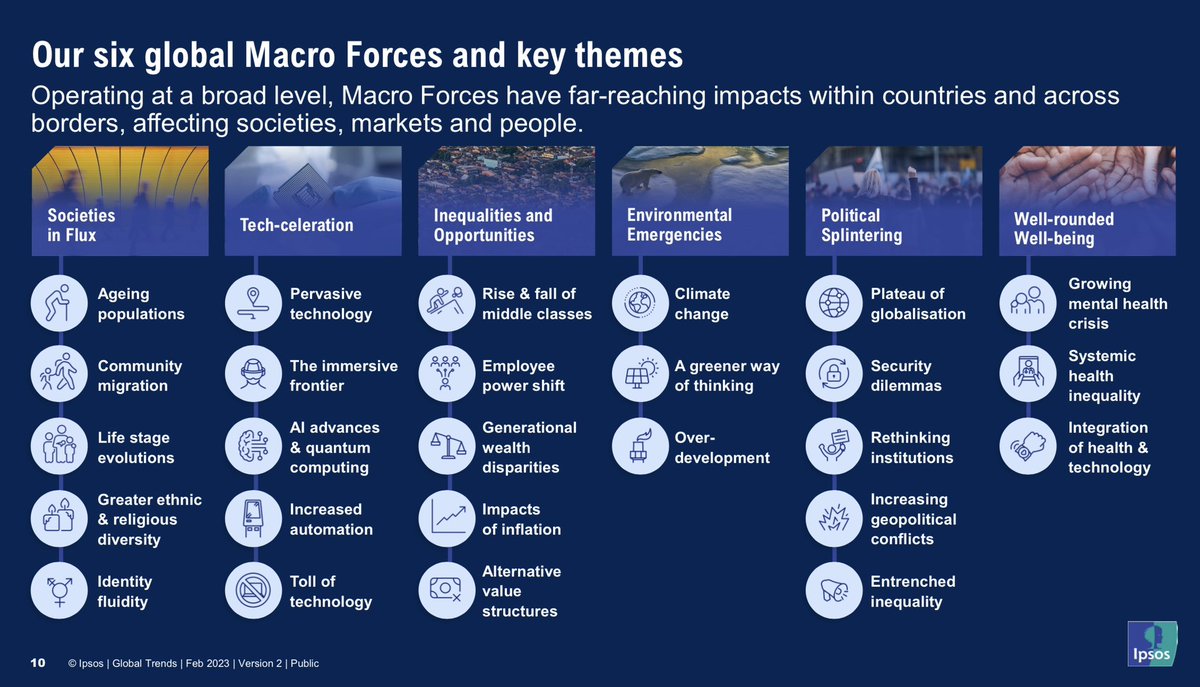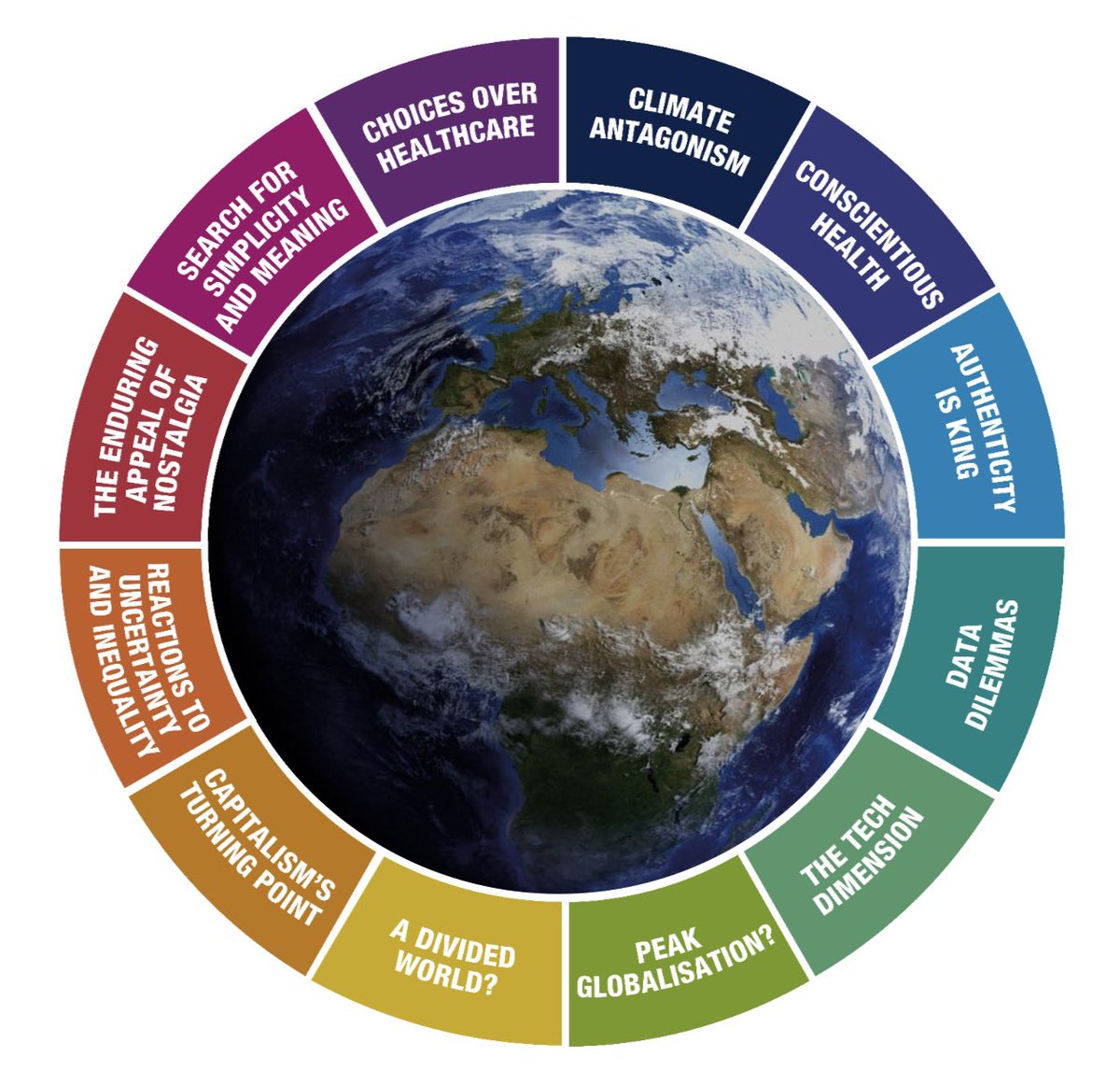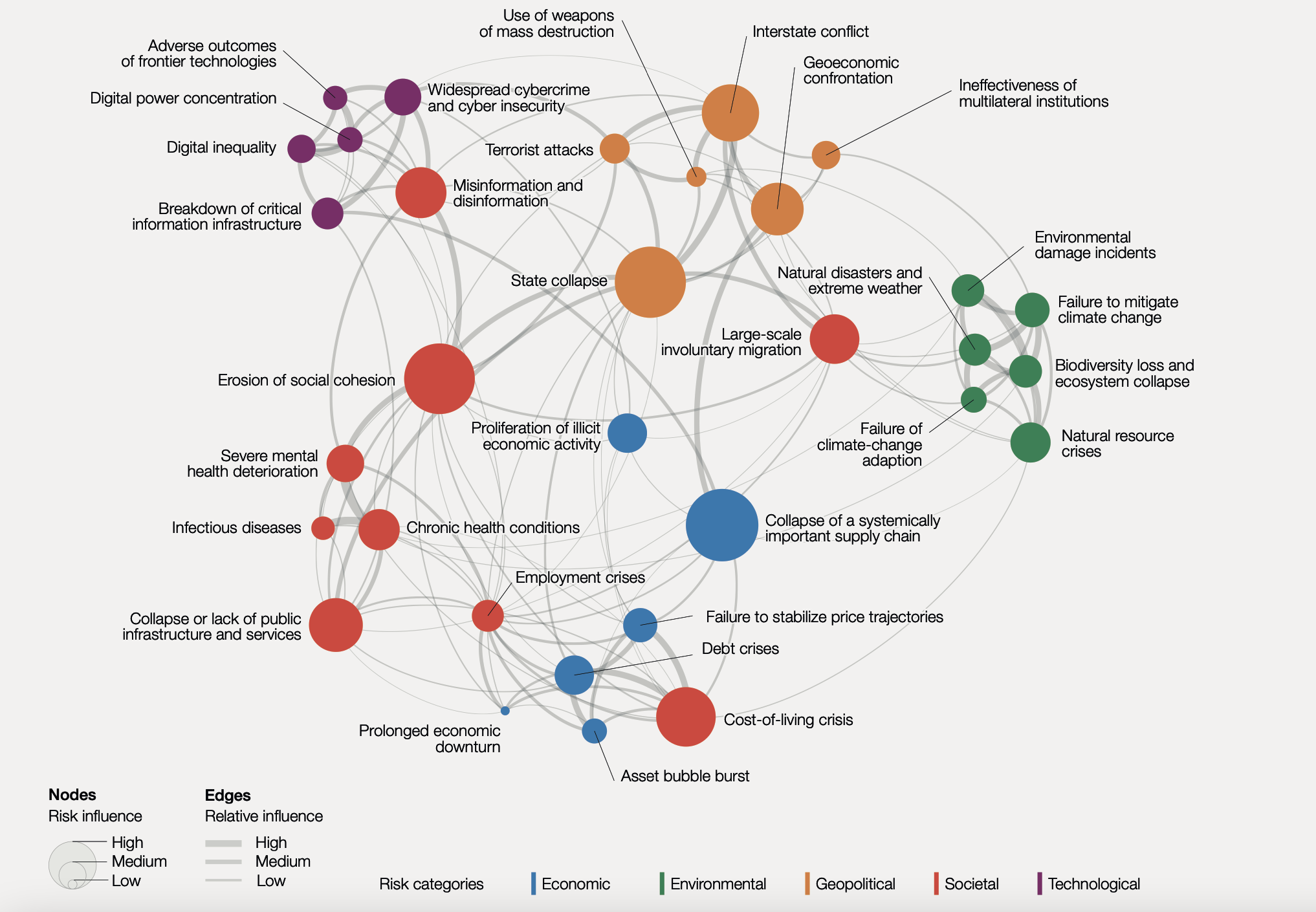Trends Kaleidoscope 2023 … exploring the most interesting ideas and inspirations for the year ahead … from perma-crisis to consequences, from meta-madness to moments of optimism.
January 1, 2023

If 2022 was the year of the perma-crisis, then 2023 will be the year of consequences.
The world, and business specifically, needs to address the impacts of inflation as it becomes recession, the continued war in Ukraine, high food and fuel prices, the transition to renewable energy, and China’s uncertain post-pandemic path. These issues, and many more, are big in themselves, but their coupling makes them even more complex to address.
“An unrestrained, impactful, and powerful burst of energy is being injected into the year ahead, arming people with hope, joy, and happiness amid continuing uncertain times” says Wunderman Thompson.
Adaptogenic beauty and absurdist stays … ageless play and artisan waves … supercharging hair and skin cycling … survivalist dining and the superself … just some of the trends in their Future 100.
It’s the age of instinct, says Canvas8 … “In the tumult of 2023, we’ll see people act on their instincts to preserve their sanity, protect themselves, and safeguard what they care about”.
So as people turn to friends, booze, and energetic rebellion, they’ll also look sceptically at who to trust, and the need to do better “While 73% of people believe companies must act for the good of the planet and society, 71% don’t believe the promises they make”.
“Sensemaking” has become a huge challenge, as the megatrends swirl around us – culturally, politically, economically – our society and markets become more granular and less predictable.
Finding the useful, important, signals – amidst so much noise – is not easy. “In a world of garbage trends and cherry-picked futurisms, which insights will unlock your next big idea?”
- Megatrends 2030, making sense of a world shaken up by Covid and more
- Reasons to be cheerful in 2023, and our progress over last 20 years
- The new business agenda, a crazy time, but also a time for new thinking
New year is also a great time for a little personal refection, and ambition setting – what did you achieve in 2022, and what do you seek in 2023? Try these:
- 2022 Personal Annual Report, “7 simple questions to reflect on the last year, and to make the next year unstoppable.”
- 2023 Year Compass, “close 2022, start 2023, because new year’s resolutions don’t work, but Year Compass does.”
Trends Kaleidoscope 2023
So, in the spirit of “new year, new ideas” here is my (not-cherry) pick from over 100 future-gazing reports for 2023. Maybe, from this smorgasbord of patterns, predications and possibilities, a few bright ideas might spark out …
“New World Disorder” is the theme of the excellent new Global Trends 2023 report from Ipsos … how to navigate polycrisis, disruption and uncertainty, change and opportunity, in the “twitchy twenties”.
Indeed “polycrisis” has become a word of the year. “A polycrisis is not just a situation where you face multiple crises. It is a situation … where the whole is even more dangerous than the sum of the parts.” says Adam Tooze, author & professor at Columbia University in New York City, New York.
Some of this year’s key findings are:
- Concern about climate change rose consistently from 2013 through the COVID-19 pandemic until the inflation crisis. It has now plateaued while climate scepticism remains. People look to brands and business – more trusted than government in most markets – to act.
- With normal life resuming in most places after the pandemic, the appeal of global brands has returned to previous levels across much of the world, especially Asia and Africa.
- While concerns about data privacy and Big Tech remain strong, data apathy continues to grow, with citizens recognising that some loss of privacy is inevitable. This coincides with a rising proportion who think that technical progress is destroying our lives as the metaverse and generative AI burst onto the global scene.
- Despite the decline of populism and nativism, the underlying ingredients – stagnating real wages, the ‘loss of the future’ and the enduring appeal of nostalgia – continue to rise. Most people expect governments not to support them adequately in the years ahead.
- With the effects of the COVID-19 pandemic echoing around the world and putting even more pressure on healthcare systems (which are facing rising demand from ageing populations), our findings confirm the rise of mental health as a key issue – especially for the young. How brands and politicians show empathy – that they are on ‘your side’ – remains important.
- Despite war and geopolitical tensions, and reshoring or ‘friendshoring’ of supply chains, most people worldwide still believe that globalisation is good for their country – a trend that has not changed since 2013.
- Finally, while most people are pessimistic about the macro environment, they remain far more positive about their own and their families’ prospects – especially in Asia. As we have found, there is more difference between markets than there is between generations, and the world remains divided on a wide range of issues.
6 global macro forces shaping every market:

Amid this backdrop of disorder, there are bright spots.
While the polycrisis impacts our overall optimism – only 31% are optimistic about the world in 2023 – we remain happy and hopeful about ourselves and our personal lives, at least: 58% of people say they’re happy overall, and 59% are optimistic about their own futures.
People do have common values, interests and goals. In fact, 79% of the world’s citizens think that brands can make money and support good causes. A growing proportion of people will pay more for brands that act responsibly (63%), and we’re generally on the same page about the climate: 79% feel that we’re heading for environmental disaster unless we change our habits.
Corporations, governments and individuals all have a role to play in solving these crises – and helping people to cope. But lack of trust is a barrier: 72% are worried that governments and public services won’t look after citizens in the future, and 54% don’t trust business leaders to tell the truth.
Ipsos see three major challenges facing people, and how organisations can offer help:
- An economic crisis hitting our wallets: There is an opportunity to rethink the structure and purpose of businesses and systems – to have a positive impact on.
- A tension between global and local: Global brands are in a unique position of power: they can bridge the gap between global and local by offering the best of both worlds.
- A climate crisis we need to solve: Through their actions, brands can have an incalculable impact on the world – through the trust they’ve already earned from their consumers.
12 global trends shaping your future opportunities:

The Economist sees five stories to watch out for in the year ahead – From India becoming the world’s most populous country, to an illegal drug that might be approved as a medicine.
1o trends will emerge from this maelstrom of madness:
- Ukraine: Energy prices, inflation, interest rates, economic growth, food shortages will all depend on how the conflict plays out in the coming months. Supply chains remain blocked, as the west’s support strengthens.
- Recession: Major economies will go into recession as central banks raise interest rates to stifle inflation, an after-effect of the pandemic since inflamed by high energy prices. Europe will be worst affected.
- Climate: As countries rush to secure their energy supplies, they are turning back to dirty fossil fuels. The Ukrainian war will accelerate the switch to renewables, and also the development of climate capture technologies, hydrogen and fusion.
- China: Some time in April India will replace China as the largest population, with 1.43 billion people. Xi is under increasing pressure economically and politically, and its businesses are being stifled. Has China peaked?
- America: Although Republicans did worse than expected in the midterm elections, social and cultural divides on abortion, guns and other big issues continue to widen. Will Trump’s ego force its way into the 2024 election, or will others rise up?
- Flashpoints: The intense focus on the war in Ukraine heightens the risk of conflict elsewhere. Chinese fighter jets are circling Taiwan. India-China tensions could flare in the Himalayas. And might Turkey try to nab a Greek island in the Aegean?
- Alliances: NATO, revitalised by the war in Ukraine, will welcome two new members. Will Saudi Arabia join the Abraham accords, an emerging bloc? Other groupings of growing importance include the Quad and AUKUS
- Tourism: As travellers engage in post-lockdown “revenge” tourism, traveller spending will almost regain its 2019 level of $1.4 trillion, but only because inflation has pushed up prices. Business travel will remain weak as firms cut costs.
- Metaverse. Reality check after all that Zuckerberg hype. Will the idea of working and playing in virtual worlds catch on beyond games? Apple launches its first headset and Meta decides whether to change its strategy as its share price languishes.
- Jargon: NIMBYs are out, VIMBYs are in, cryptocurrencies are uncool and post-quantum cryptography is hot, and passwords will give way to passkeys, and then there are frozen conflicts, and synfuels. Work them out.
The Global Risks Report 2023 by WEF and McLellan takes this further, identifying short and long-term risks – and importantly, their connectedness, which matters if we are to work out how to address them in effective ways.

Top of the short-term risks, globally, is the “cost of living” crisis, as a crunch of economic stagnation, disrupted supply chains, energy prices and much more, all contribute to pressure on individuals. However climate change is still, by far, the most significant longer-term risk, which demands action now or never.
Accenture Life Trends (previously Fjord) identified five emerging trends that will alter the power dynamic between brands and customers this year. Emerging technologies such as AI, web3, and tokenization are redefining creativity, brand engagement, and autonomy.
They identify 5 consumer trends:
- I will survive … The world is lurching from one global catastrophe to the next. But, as they have for millennia, people are adapting to instability by switching between four responses: fight, flight, focus and freeze.
- I’m a believer … In an unstable world, people seek out places where they feel they belong. As a result, next-gen brands will be built as communities first, reshaping loyalty and brand participation.
- As it was … Everyone’s felt the loss of intangible office benefits, like chance encounters and consistent, close guidance of junior talent. Now, the consequences of the loss are becoming clear. Without in-person engagement companies stand to lose.
- Ok, Creativity … Whereas AI largely has been used by enterprises and brands as a service to people or on people, neural networks have been made widely available to create language, images and music—putting AI squarely in people’s hands as a tool for creativity.
- Signed, sealed, delivered … The use (and misuse) of personal data is long overdue for a transformation. Transparency and trust in online brand experiences are quickly diminishing in tandem.
And there are many, many more trend reports – each with their own spin on the zeitgeist, and what will emerge next. Each seeking to creatively articulate normal people in ever psychedelic terms, usually with plenty of bias too:
- DFF 10 Megatrends Shaping our Future 2023
- Trend Check 2023 by Trendwatching
- Marian Salzman Rethinking Everything
- Ipsos 2023 Gamechanger Predictions
- GWI “Connecting the dots” consumer trends
- Foresight Factory Consumer Trends 2023
- The New Consumer Trends Report 2023
- Instagram Trend Report 2023
- TikTok Trend Report 2023
- WEF Chief Economists Outlook 2023
- BlackRock’s Global Investment Outlook 2023
- And 100 more curated by SpaceCadet
For marketers, also check out the free Most Contagious Report 2022

Mintel’s 2023 Consumer Trends report has one of the largest global insights bases. Over the next one-to-five years, they say, expect consumer behaviour to shift and evolve in response to the following five global consumer trends:
- Me Mentality … Consumers will be eager to re-focus on themselves and brands can help them take centre stage.
- Power to the People … Brands have to make room for a new ‘c’ in their c-suite as, consumers are investing, co-creating and voting for change alongside brands.
- Hyper Fatigue … Consumers will try to cut through the noise and connect with what matters to them.
- International Localism … Buying local will be a way consumers can protect themselves financially, environmentally and psychologically, and feel that they are giving back.
- Intentional Spending … Factors like flexibility, durability and sustainability will play increasingly important roles in consumers’ value equation.
Meanwhile Wunderman Thompson’s Future 100 An unrestrained, impactful, and powerful burst of energy is being injected into the year ahead, arming people with hope, joy, and happiness amid continuing uncertain times, according to ‘The Future 100: 2023’ from Wunderman Thompson.
Despite on-going economic and environmental crisis, people are choosing joy … the ‘Joy-Conomy’, the rise of trends such as ‘Elevated Expressionism’, ‘Feel-Good Feeds’, and ‘Ageless Play’, demonstrates the opportunities for brands who engage with consumers’ desire for inspiration and optimism, as people become are determined to show resilience, innovation, and joy in the face of continued hardship – as last year’s unbounded optimism shifts to an exuberant need for uplift and play.
In addition to the rise of the ‘Joy-conomy’, other trends include:
- Indigenous Innovation: Indigenous Techniques are forming regenerative approaches to managing the environment
- Techcessibility: Companies are redesigning their digital environments for greater accessibility
- Temperate Travel: Rising temperatures will prompt travelers to seek out cooler destinations
- Amplifying Diverse Creators: Growing calls for authentic representation in advertising are driving a wave of brand collaborations with marginalized creative talents
- Cell-cultured Dishes: As cell-cultured food moves from lab to grocery store, luxury dining may be the first beneficiary
- Resurrected Ingredients: Brands are bringing back extinct and forgotten sensory ingredients
- Crisis Retail: As the financial crisis bites, brands are stepping up to help their most vulnerable consumers
- Residence at Sea: The next-gen digital nomad is taking to the sea—in style
- Menopause Retreats: From HRT education to nutritional advice, retreats designed specifically for the menopause journey are on the rise
- Generation Flex: Employee expectations are rising. Despite economic woes, could the balance of power be tipping in their favor?
They also identify some new vocabulary for the year ahead:
- Joyconomy: a movement of brand and consumer enthusiasm for elevated expressionism, positivity, and forward-thinking advancements across industries.
- Situationships: mutually temporary relationships that fill an emotional need or compliment a lifestyle change that allows for ever-shifting boundaries from both parties.
- The superself: an all-encompassing wellness lifestyle that sees people centering their lives on the betterment of their mental and physical health.
- Rewirement: retirement, reestablished for workers who want to pursue personal passions and rediscover themselves.
- Hospital-ity: healthcare and hospitality practices combined to cater to the super-health-conscious traveler.
- Digital nesting: established liminal lifestyle and home spaces that incorporate digital and physical habits and commodities.
- Climate optimism: a meaningful, positive response to anxiety over climate change.
- Techcessibility: accessible designs in tech that include necessary adjustments and considerations for marginalized groups.
- Unretirement: to return to work post-retirement for economic stability and meaningful social interaction.
- Cryptoclubs: member-based digital communities that unlock exclusive opportunities for the crypto-elite.
Scott Galloway is a digital-world professor who knows what he loves, and hates.
Take this “I hate Meta and … its equity will outperform the market. The Zuck’s growth plan (the metaverse) is something his most formidable enemy could not have dreamt. We said this before it was cool, and the market concurred this year and took the stock down 75%. In one year, Meta lost its gains from the previous five. Sure, the metaverse is dumb/stupid/ridiculous, but Meta is still a $120 billion business and a cash volcano with (despite Zuck roofieing his colleagues with a Big Gulp Grande Venti ayahuasca trip to the metaverse) exceptional operating margins. Facebook and IG are no longer the hot new thing, but the population of the Southern Hemisphere and India still use them.”
So how else does he see the year ahead?
- Hyper AI ... Like Web3 last year, artificial intelligence is on track to be the most hyped technology of 2023. Unlike Web3, however, AI will (mostly) live up to the hype. We’ve already witnessed the immense capabilities of image- and text-generating AI programs, including Midjourney, Stable Diffusion, and ChatGPT.
- Bytedance … Apple and TikTok have been shaking up the ad world. Apple is already a multi-trillion-dollar firm, and TikTok will cut the ribbon on its four-comma valuation this year. At its current $300 billion valuation, TikTok’s parent, ByteDance, is worth more than Disney, Snap, Pinterest, Twitter, IPG, WPP, and the Omnicom Group combined. It took just five years to reach a billion users — three years less than Instagram and four years less than Facebook — and those users spend 100 minutes/day on the platform. When young people are asked to choose between TikTok and all of TV/streaming, they choose TikTok.
- Subscale … Downturn markets morph large firms into firms that are not large enough. We could see the consolidation of many subscale companies, including Lyft, AMC, Peloton, Carvana, and Robinhood. In terms of market cap, Uber is now 15 times more valuable than Lyft, as are Ford and GM, who are hungry for autonomous driving experience and IP.
- Airbnb … Galloway believes the best-performing large tech stocks of 2023 will be Airbnb (alongside Meta). Seventy percent of the company’s site traffic comes from direct, organic visits — that’s compared to 40% for Marriott and Expedia. This brand strength results in a net margin twice those of its hospitality peers. Airbnb also generates half a million in revenue per employee, more than most tech companies — and ten times greater than hotel chains. The company can reinvest at a rate that will further increase the delta between the business and its peers.
- Disneyverse … Could Disney acquires Roblox? Roblox is a metaverse that works. The gaming platform has roughly 60 million daily active users, half of them 13 years old or younger. At the beginning of the year the stock was $120; it’s now below $40. At Disney, Bob 1 is back, and he may be the best buyer in history. During his first stint he acquired Pixar, Marvel, Lucasfilm, Bamtech, and 21st Century Fox. (We’ll ignore the last one.) Acquiring Roblox would be expensive, but Disney has the capital, and strategically it makes sense.
- Tesla … He concludes “Scott Fitzgerald defined intelligence as the ability to hold two opposite ideas in the mind at the same time. Tesla will post record revenue and deliveries next year, and the stock will still get cut in half. I’ve been a Tesla bear for a long time, which means I’ve been (very) wrong for a long time. The lesson was to “never bet against a company with a great product.” And that’s still true. The problem for Tesla is that greatness is relative, and the industry is catching up.”
And some positive foresight to end on. I’ve always been a fan of Springwise, created by Rainer Evers and his team in Amsterdam.
They kick off by saying the last twelve months have been an exciting time for innovation, with several important milestones passed. Here are five trends we believe will impact the world of innovation in the year ahead.
Protein possibilities … In July this year, Google-backed DeepMind announced that its AlphaFold programme had uncovered the structure of 200 million proteins – almost all of those known to science. This breakthrough is likely to speed up the development of protein-based innovations in the coming years, with implications for everything from food security to plastic recycling. But when most of us hear the word ‘protein’, we think of food. And here too we expect to see innovation in 2023.
Two protein innovations set to come of age in 2023:
- A plant that will convert methane into protein for animal feed
- Dairy proteins produced from plant cells
Satellites for nature … Satellites may seem distant, but they impact our daily lives in many ways – from providing internet to helping us navigate through Google Maps. And scientists have long been using them for all kinds of research. But as the importance of nature-based solutions such as reforestation grows, and the impacts of climate change become more apparent, we are increasingly seeing satellites used for monitoring vital ecosystems and tracking climate impacts.
Two satellite innovations set to come of age in 2023:
- Using satellites, AI, and LiDAR to map every tree
- A micro-satellite constellation set to monitor water availability
A real estate reckoning … With buildings responsible for 39 per cent of global energy-related carbon emissions, innovators are increasingly reckoning with the need to decarbonise real estate – both through cleaner construction and retrofitting. And this is likely to accelerate next year.
Two real estate innovations set to come of age in 2023:
- A 3D-printed house made of bio-based materials
- An AI platform for de-carbonising real-estate portfolios
Green is the new black … Fashion has long been criticised for its poor sustainability credentials. But as pressure on the industry grows, innovators are increasingly working to give fashion a makeover. This year, we have seen developments such as compostable materials and platforms that create a market for unused fabric. And next year we expect to see even more innovation.
Two fashion innovations set to come of age in 2023:
- A website plugin helping shoppers find the correct size for any brand
- A fashion brand converting to fully circular production
Cultural creativity … Innovation is not limited to the world of business. The impact of digital technologies on art and culture has been nothing short of transformative. And in 2023 we expect to see some exciting creative developments.
Two arts and culture innovations set to come of age in 2023:
- A catamaran converted into a digital art museum
- ️ A metaverse space for museums.
Seize the recession to your advantage
Economic downturns are the moments when markets are shaken-up, when the poor performers are shaken-up, and when the innovators step up.
56% of Fortune 500 companies were founded during an economic downturn. 92% of patents are filed during a downturn. Most upturns are forged during the preceding downturn.
When others are losing their heads, will you seize the future?
- Beyond the downturn: recession strategies by Bain
- How to survive a recession, and thrive afterwards by HBR
- Preparing for and managing through a downturn by McKinsey
- How to market in a downturn by HBR
- The next consumer recession, preparing now by Deloitte
- Building resilience in a time of uncertainty by BCG
More from Peter Fisk
- Next Agenda of best ideas and priorities for business
- Megatrends 2030 in a world accelerated by pandemic
- 49 Codes to help you develop a better business future
- 100 companies innovators shaking up the world
- 100 leaders with the courage to shape a better future
- Education that is innovative, issue-driven, action-driving
- Consulting that is collaborative, strategic and innovative
- Speaking that is inspiring, topical, engaging and actionable
More from the blog